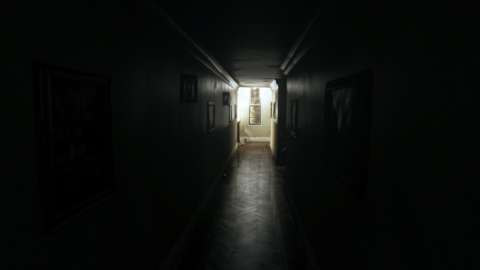There was a time once, when I'd have to wring out a year's worth of entertainment from the single game I'd get gifted during the holidays. I'd internalize its minutiae, commit every inch to memory...and maybe that'd take me to March. That left nine more months to meticulously probe the walls of every level like a Jurassic Park velociraptor looking for a weak point in its cage. When you only get one game a year, every play-through is a deep dive.
P.T. is that in microcosm. It brooks no other playstyles. Your unidentified character awakens in a room, that room leads to a hallway, and that hallway leads to... the same hallway, ad infinitum. The two of you grow quite acquainted. You learn all its creaks and its corners; by now, I could probably navigate my way to its bathroom in the dark as though it were my own apartment. Though my bathroom doesn't come with the bloodstains and spectres.
Dead By Daylight | Official Castlevania Teaser Trailer Project T (New Dead By Daylight World Game) | A First Look The Casting Of Frank Stone | Official Story Gameplay Trailer Dead By Daylight X Dungeons & Dragons | Official Cinematic Reveal Trailer Dread Delusion 1.0 Launch Trailer Robobeat | Official Launch Trailer Diablo 4 | Loot Reborn | Gameplay Trailer Stumble Guys - Official PlayStation Launch Trailer Samurai Warriors 4 DX - Steam Launch Trailer Valheim: Ashlands - Official Animated Release Trailer Homeworld 3 | Official Launch Trailer Stellar Blade - Accolades Trailer | PS5 Games
Please enter your date of birth to view this video
By clicking 'enter', you agree to GameSpot's
Terms of Use and Privacy Policy
So yes, something's afoot. Maybe it has something to do with the conspicuous radio broadcast that greets you when you step through the first door, about a man killing his entire family? Just maybe. But P.T.'s horror is a slow burn, all the same. Each lap you make--into the hall, past the foyer, out the side door--changes something. Sometimes it's immediately clear: the hallway lights are out, perhaps, or there's a disconcerting new sound coming from inside a locked room. Sometimes it's slower to reveal itself. Advancing the narrative is usually a matter of finding whatever's new and inspecting it (“press R3 to look closer” is the long and short of the command list), and as you're sifting domestic entrails for some deeper meaning in old photographs or loose pills you're often rewarded with the ominous creak of a door's swing somewhere behind you. While the playable area of the game is almost oppressively small, it plays the angles well, and packs the hallway with blind corners that have you gritting your teeth each time you swing around.
P.T provides a few “cleanout” points along its narrative pipeline: moments where the game seemingly resets at a logical enough end point, and players can opt to step away rather than travel further down the rabbit hole. If you don't take them, expect to find that newly added puzzles quickly get too esoteric for the average player to solve on their lonesome. That's part of the conceit, however. There's a viral element to P.T.: the game was designed specifically to be parsed and over-scrutinized by a community of invested fans, with the expectation that the collective conscious would crack its codes after a week or two. It happened a lot sooner than that, of course, and the answers are up online for anyone looking to see the game through to completion. Is that cheating? I don't think so. Analyze games long enough, and you come to appreciate that a video game is a hazy, moving target, not at all confined to the data encoded on its disc or download. In the case of P.T., it's worth a jaunt online to see the inspired community's findings.

Back in those younger days when I only played a single game for years at a time, I used to be pretty susceptible to video game myths. Or at least, I had the free time and the layabout's wherewithal necessary to pursue the winding threads alleging ways to resurrect Aeris, or get to the secret island in Goldeneye's Dam level. You probably know the type: “take 10 steps left, 4 steps right, wait eight hours, collect ninety-nine of this obscure item, then discard them all during a full moon while listening to The Beatles' 'Strawberry Fields Forever' played backwards.” Stuff like that. The Internet's gotten pretty good about snuffing those out these days, so it's a special game that can restore mystery into the act of play. The solutions to P.T.'s later puzzles are every bit as cryptic as those old instructions to unlock the fictive nude mode in Tomb Raider.
Much of the beauty of P.T. lies in how naturally it directs that occultist spirit towards a genre that can readily receive it. Horror greatly benefits from that sort of sense of community mythos (see: Man, Slender), that makes what were once just campfire stories feel multifarious and real. Critically, there's also a subtle amount of randomness to the way events unfold in P.T., so those shared experiences frequently belie unexpected scares, and a depth and sense of mystery that can occupy your mind for days after.
What's P.T. all about? Maybe you know the answer already, but if you don't, well, don't worry about it. P.T.'s a game worth experiencing in its own right, and even though its hallway is small, it'll take you to some unexpected places.